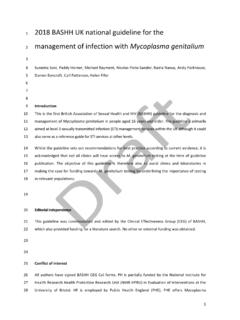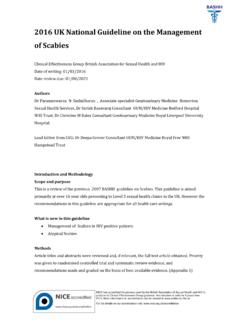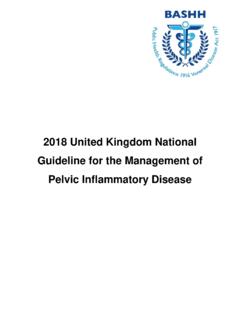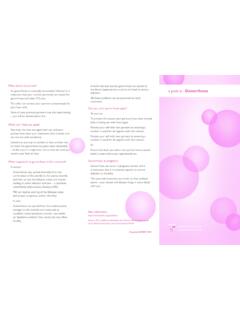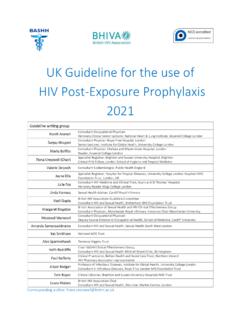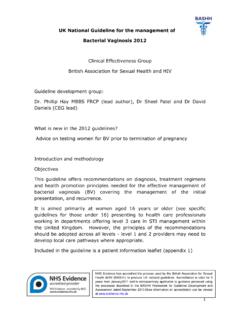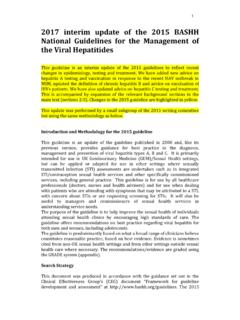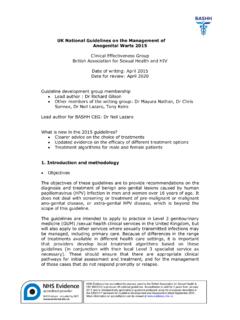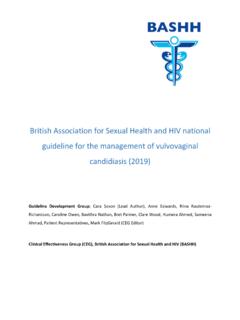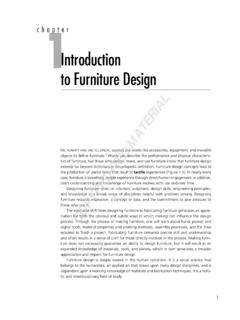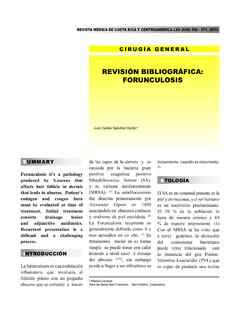Transcription of United Kingdom BASHH national guideline for the …
1 United Kingdom BASHH national guideline for the management of epididymo-orchitis, 2019 Clinical Effectiveness Group British Association for Sexual Health and HIV Dr Mimie Chirwa (co-chair), Specialty trainee, Genitourinary medicine, Chelsea & Westminster Hospital NHS Foundation Trust, London Dr Olubanke Davies (co-chair), Consultant, Genitourinary medicine, Epsom & St Helier University Hospitals NHS Trust Mrs Sheena Castelino, Pharmacist, Genitourinary medicine. Guy s & St Thomas Hospitals NHS Foundation Trust, London Dr Mbiye Mpenge, Consultant microbiologist, Weston Area Health NHS Trust, Weston-super-Mare, Somerset Dr Farai Nyatsanza, Consultant, Genitourinary medicine, Cambridge Community Services NHS Trust, Cambridgeshire Dr Cindy Sethi, Consultant, Genitourinary medicine, Guy s & St Thomas Hospitals NHS Foundation Trust, London Mr Majid Shabbir, Consultant urologist, Guy s & St Thomas Hospitals NHS Foundation Trust, London Patient representative.
2 Recruited from a London clinic Dr Michael Rayment, Consultant, Genitourinary medicine, BASHH Clinical Effectiveness Group Editor 2 New in the 2019 guideline Aetiology Tuberculous epididymo-orchitis following BCG bladder instillation for bladder cancer Consideration of non-infective pathologies such as vasculitis and rare infections such as brucella where indicated in the clinical history Further investigations Brucella serology should be considered in patients from a brucellosis endemic area Colour duplex ultrasonography (CDU)
3 Is not reliable enough to make a diagnosis of testicular torsion in all settings as it has a user dependent false negative rate. It is recommended that patients with suspected clinical torsion should undergo an urgent exploration of the testis Treatment First line empirical treatment for epididymo-orchitis most probably due to any sexually transmitted pathogen is now with ceftriaxone 1g intramuscularly and Doxycycline 100mg twice daily for 14 days Consideration of 1g ceftriaxone intramuscularly + ofloxacin 200mg twice daily for epididymitis likely caused by sexually transmitted chlamydia and gonorrhoea and enteric organisms Consideration of
4 Ofloxacin 200mg twice daily or levofloxacin 500mg once daily for epididymo-orchitis most probably due to enteric pathogens Where Mycoplasma genitalium has been tested and identified, treatment should be guided to include an appropriate antibiotic ( moxifloxacin) Sexual partners Sexual partners should be tested for other STIs including HIV testing and given treatment with antibiotics to cover C. trachomatis and N. gonorrhoeae if confirmed in the index patient Follow up Uropathogen confirmed epididymo-orchitis is an indication for urology referral in order to exclude structural abnormalities/urinary tract obstruction 3 Scope and purpose The main objective of these guidelines is to offer recommendations on the diagnostic tests, treatment and health promotion principles in the effective management of epididymo-orchitis.
5 It is aimed primarily at the care of people aged 16 years or older presenting to health care professionals, working in departments offering level 3 care in STI management within the United Kingdom . However, the principles of the recommendations could be adopted at all levels. Rigour of development The British Association for Sexual Health and HIV: 2015 framework for guideline development and assessment ( ) was used to develop these guidelines. A Medline search was performed for 2009-2017 using the keywords epididymitis , orchitis and epididymo-orchitis.
6 The Cochrane Database of Systematic Reviews and the Cochrane Controlled Trials Register up to 2017 were reviewed using the same keywords. Conference abstracts for British Association of Sexual Health and HIV, Federation of Infection Societies, and urology conferences were reviewed as were guidelines from Centers for Disease Control and Prevention, European Association of Urology, and International Union against Sexually Transmitted Infection guidelines. Further references from articles identified were included. Article titles and abstracts were reviewed and full texts of relevant articles reviewed.
7 Meta-analyses of randomised controlled trials (RCTs), RCTs and systematic reviews were prioritised and recommendations were made and graded based on the best evidence available. A patient representative was recruited from a London sexual health clinic. They were involved in the development of the first and later drafts of the guideline as well as the patient information leaflet. An equality impact assessment was undertaken and is published on the BASHH website. Prior to publication, the guideline was appraised using AGREE II by CEG, and then placed on the BASHH website for a two-month consultation period inviting all BASHH members to submit comments to the CEG.
8 The guideline was also reviewed by the BASHH Public Panel. This guideline will be updated no later than 5 years after publication. 4 Introduction Acute epididymo-orchitis is a clinical syndrome consisting of pain, swelling and inflammation of the epididymis +/- testes. This may result from infectious and non-infectious pathologies. The most common route of infection is local extension and is mainly due to infections spreading from the urethra (sexually transmitted pathogens) or the bladder (urinary pathogens). Aetiology Bacterial Under 35 years - most often a sexually transmitted pathogen such as Chlamydia trachomatis and Neisseria gonorrhoeae [1-12].
9 Over 35 years - most often non-sexually transmitted gram negative enteric organisms causing urinary tract infections [1-12]. Particular risks include recent instrumentation (such as prostatic biopsy and vasectomy) or catheterisation [13-16]. There is crossover between these groups and complete sexual history taking is imperative [3, 7-9, 11, 12]. Men who engage in insertive anal intercourse are at risk of epididymitis secondary to sexually transmitted enteric organisms [1, 17, 18]. Abnormalities of the urinary tract such as anatomical or functional abnormalities are common in the group infected with Gram negative enteric organisms.
10 Approximately 20% of male cases with anorectal malformations (ARM) develop epididymo-orchitis [19]. In cases of suspected edidymo-orchitis with a history of ARM, a recto-urinary communication or neurogenic bladder following anoplasty should be considered [19,20]. All patients with a confirmed urinary tract pathogen should have further investigations of the urinary tract [21,22]. Ureaplasma urealyticum is found in men with epididymo-orchitis, often in association with N. gonorrhoeae or C trachomatis infection. Evidence supporting it as a common cause of epididymo-orchitis is lacking [5, 12, 23] Mycoplasma genitalium is a slow-growing micro-organism, replicating intracellularly and extracellularly and able to establish latent or chronic infections (24).
